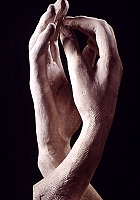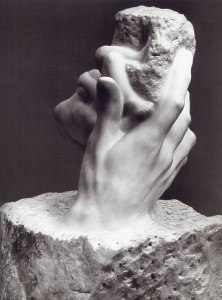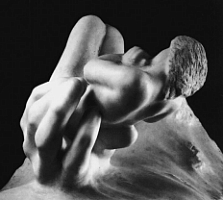Rodin Works: the hand of god and other hand studies |
|
In the late 1880s, Rodin began with several studies of hands. The idea to
model hands separated from their bodies was inspired by the photographer Eadweard Muybridge in 1887, who made a series of hands with dramatic
gestures, silhouetted
against a dark background. For Rodin, who by this time started to fancy
fragmentary sculptures, such isolated hands still had the complete
capacity to express emotions. The 'Hand of God' was probably derived from a hand modeled for Pierre and Jaques de Wissant in the 'Burghers of Calais'; one of these open hands, with the typical gesture of the thumb bent outwards, was cast in bronze, directed upwards, under the title 'Large Hand of Pierre de Wissant'. In 'the Hand of God', a nearly identical hand is shown creating man and woman from a lump of clay; the hand itself evolves from a block of rough marble, so duplicating the theme of creation from formless material. In 1898, Rodin told the Gazette des Beaux-Arts: "When God created the world, it is of modeling he must have thought first of all."
There are three different versions of 'The Hand of God', varying in the size. Athena Spear points out that the first version of 'the Hand of God' - 12 inches - was later enlarged to 28 inches and also reduced to 6 inches. As a counterpart to the 'Hand of God' Rodin created the 'Hand of the Devil Holding Woman' around 1903. The title leaves room for the interpretation that Rodin, at times, perceived womanhood as a diabolic invention. |



